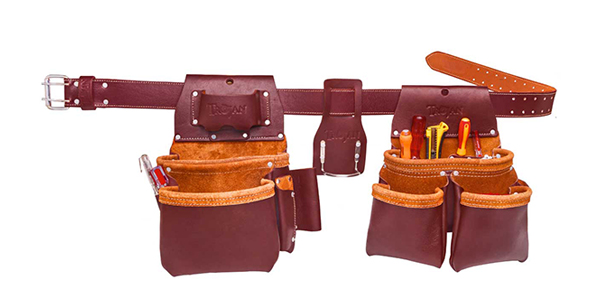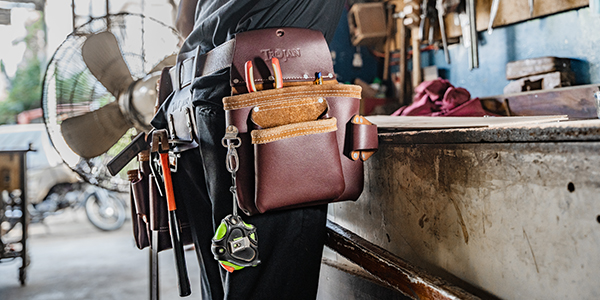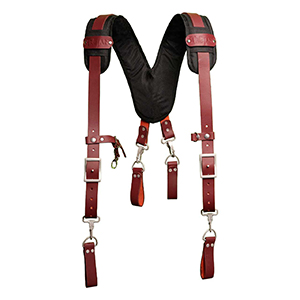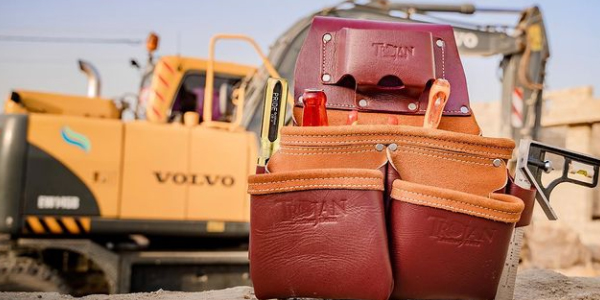How to Wear a Tool Belt?
We surveyed professionals and requested them to tell us how to wear a tool belt. Do they keep their bags in front, sides of, back? Here’s what they told us.
How to Wear a Framing System?

One professional said:
“I have multiple sets of bags. Evidently, I wear them differently depending on what job I’m doing. For framing, they are on my side. Therefore, I can easily pass through between wall studs. Furthermore, my siding and trim bags ride on my back. It makes it easier to safely negotiate ladders and scaffolding. However, I like an apron-style set of bags in the front if I’m doing interior trim. Obliviously, it is less likely that my tools will accidentally gouge the walls or damage the trim”.
Another one of the pros with over three decades of experience said about wearing a tool belt:
“About 30 years ago, I did a lot of framing and roofing. Pneumatic guns were newer, so I wear mine to the side to keep my stick nails and basic tools at my side and coil nails and two-way radio in the back. However, now I do more repair work and remodelling, so I no longer wear a belt unless I am up a ladder or on a pick. I still wear it to the left side”.
How to Wear a Carpenter System?

He has said it all:
“Clearly, I always have loose tool bags that can move on the tool belt. In other words, adjust as needed for tight spaces and what you are doing right now. Moreover, loads on the sides where your hands naturally fall most often. But they can quickly move to the back when they get in the way or bang into your work. If you are right-handed, hammer on the right side on the back edge of the bag. Most of your right-hand tools, pencil, utility knife, scribe, and other tools are in the right bag. Fasteners, nails etc., on the left bag.
Left bag tools, cats paw, combination square, plumb bob, nail set things you use with your left hand. Adjust your tools to what you are doing, not everything you may do on the whole job. Consider having two sets of tool bags. One set for building site preparation and rough work.
Moreover, a second set for general construction. Obviously, keep the tools you will need, but don’t expect to use them in the next three or four hours. Modify your tool bags as needed, use add on pieces if they work for what you are doing. In addition, try spenders; see how they work for you. Avoid the enormous tool bag sets. They really can get in the way and make for an unnecessarily heavy load”.
This carpenter has a reason for keeping the bag front, sides or back:
“Wear it both ways; depending on what I’m working on it and where I’m working at! In other words, if I’m working in the field I wear it on the back or sides. For example, if I’m working on a bench (like in my shop), I might wear it in the front. Furthermore, besides doing construction and being a mechanic- I also was a faithful follower and an arborist-doing those activities, I wore my utility belt in the back to climb better with fewer things getting in my way as I was manoeuvring.
Importantly, if I’m going to be manoeuvring a lot of the utility belt in the back- if I am going to be stationary most of the time, I might consider wearing it in the front- sometimes I forget what tools I had with me, and it made the job a lot harder because I couldn’t see them and that they were on the utility belt. Wearing on the sides is good. I used to like wearing my hammer in the back; not like other tools where you might forget you have one, always know you supposed to have a hammer, lol”.
A carpenter shares his experience with wearing a tool belt:
“I’m a GC and I do carpentry primarily, remodels, and lots of exterior work, and I wear my tool belt and pouches on the back and sides. Occasionally, I add a bolt bag upfront to hold nail strips when framing. Still, it doesn’t get in the way because if you do any bending/kneeling or climbing ladders, you have to wear it on the back, but I can see how it would be advantageous if you stood upright all day in a shop setting to wear everything upfront.
Moreover, I have different techniques for different applications. The door installer I used wore his belt up front, and it looked absurd to me, but he did fantastic work and practically worked miracles, so I kept my thoughts to myself. Now I realize his position choice probably worked best for him, whether intentional or not”.
Attaching the Suspenders

Here is another interesting answer to how to wear a tool belt:
“My belt has pouches on the sides, with small ones on the front along my waist, which leaves the back open to hang power tools such as drill/impact or whatever I happen to be using it at the time. Moreover, if it’s getting weighed down a lot I’ll use suspender straps as well. Wearing the kind of belt you have on the back seems off. I always use that style in the front but usually opt for my standard side pouch belt though it depends what I’m doing”.
Attaching the Pouch

Here is an exciting hack for those who have to carry lots of fasteners:
“A trick I picked up some years ago is to cut the top off a quart of automotive oil bottle, wash it out thoroughly and use it to carry nails or screws (I sometimes frame with both) in your pouch. The plastic container is more accessible (for me, at least) to grab nails from, saves wear on the pouch, and can be used to scoop nails or screws from a bucket or box then dropped back into the pouch without dropping any in the wrong pouch. In the larger pouches, I’ve also used the bottom of a narrow laundry detergent bottle”.
We like what this gentleman has to say about attaching the pouch:
“I think it depends on the Trade. AS YOU SAY, if I’m doing installation work, I will turn it behind. I use a CLC and have pouches on the sides, including an Impact holster right in front of the pouch, and a hammer (if needed) back left behind the pouch. In other words, I have different pouches for different work, Electrical, Framing, and so on. Furthermore, if I’m in the woodshop or framing and I need to access single nails or screws, I use my Canvas belt and turn to the front.
In conclusion, the most commonly used way of wearing a tool belt is keeping the bags on the side. Keeping in the back is the second most common way of wearing a tool belt”.

